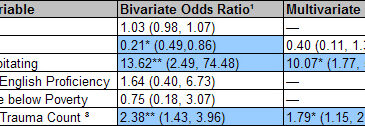Recent research shows that Cambodian refugees who settled in the United States suffer from disproportionately high rates of trauma (Marshall, Schell, Elliott, Berthold, & Chun, 2005). Other research shows that they also might be more prone to disordered gambling (Petry, Armentano, Kuoch, Norinth, & Smith, 2003). This week the WAGER reviews a study that examines whether socio-demographic variables and trauma are significant correlates of lifetime disordered gambling among a sample of Cambodian refugees (Marshall, Elliott, & Schell, 2009).
Methods
- Study participants (n=127) were a subsample of Cambodian refugees residing in Long Beach, California. The researchers recruited study participants by using a three stage random procedure:
1) Screening: Census tracks identified areas with the highest concentration of Cambodian residents. The researchers screened 2,001 (97%) of the identified households for eligibility.
2) Eligibility: Participants aged 35 to 75 were eligible if they previously lived in Cambodia during part of the Khmer Rouge regime. This process identified 719 Cambodians as eligible from 586 households (29%).
3) Random Recruitment: One eligible person was selected randomly from each household; 490 participants agreed to participate. - Subsample: The researchers added gambling-related questions to the core study after enrolling approximately 75% of participants. The 127 subsequent participants were used in this study.
- Face-to-face interviews assessed the following variables:
- Socio-demographic variables: age, gender, marital status, English proficiency (dichotomized as good or fair vs. poor or no ability) and household income (dichotomized as above or below the federal poverty line).
- Pre-immigration trauma exposure: assessed 35 events using items from the 17-item Cambodian Harvard Trauma Questionnaire (Mollica et al., 1992) and the 46-item Bosnian version of the Harvard Trauma Questionnaire (Allden et al., 1998).
- Disordered gambling classification (i.e., problem or potential pathological gambling) assessed using the South Oaks Gambling Screen (SOGS; Lesieur & Blume, 1987). A score of 3 or more indicated disordered gambling.
- The researchers conducted bivariate and multivariate logistic regression analyses to examine the relationships between the socio-demographic and trauma variables and disordered gambling. They reported the results as odds ratios; Table 1 summarizes these findings.
Table 1: Odds Ratios and 95% Confidence Intervals (CI) for Predicting Disordered Gambling (Adapted from Marshall et al, 2009)

Click image to enlarge, or adjust your browser’s zoom setting.
¹Analyses are weighted and adjusted for clustering resulting from sample design
²Odds ratios are adjusted for variables with P-values less than 0.05 in bivariate models
³Per Standard Deviation
*P < 0.05
**P < 0.01
Results
- Eighteen participants (13.9%) met criteria for disordered gambling.
- Table 1 indicates that disordered gambling was significantly correlated with:
- Being male (bivariate analysis only)
- Being married/cohabitating
- Being exposed to high levels of trauma
Limitations
- The rate of disordered gambling had large confidence intervals; anywhere from 4% to 24%.
- The results might not generalize to other populations, including other populations of Cambodian refugees.
Discussion
The results indicate lower rates (13.9%) of disordered gambling compared to the rates observed among Asian refugees in a similar study (i.e., 70.0%; Petry et al., 2003) that also used the SOGS with the same scoring classification. One difference between the two studies is that the Petry et al. study examined a convenience sample of refugees from three Asian communities (Laos, Cambodia, and Vietnam) at Asian community service organizations in Connecticut. Marshall et al. randomly selected a sample from a large Cambodian refugee community. Regardless, rates of disordered gambling appear to be meaningfully higher among Asian refugees than those observed in the general population (i.e., 1.4-2.9%; Kessler et al., 2008; Petry, Stinson, & Grant, 2005).
The correlation between traumatic events and disordered gambling in this study is consistent with other research (Kausch, Rugle, & Rowland, 2006); however, Marshall et al. found that marriage/cohabitation was significantly associated with disordered gambling. This finding contradicts other research (e.g., Petry et al., 2003; Petry et al., 2005), which reported positive associations between being divorced or single and disordered gambling. As a result, further examinations of disordered gambling and meaningful disordered gambling correlates among Cambodian refugees and other refugee communities are warranted.
-Tasha Chandler
What do you think? Please use the comment link below to provide feedback on this article.
References
Allden, K., Ceric, I., Kapetanovic, A., Lavelle, J., Loga, S., & Mathias, M. e. a. (1998). Harvard trauma manual: Bosnian-Herzegovina version. Cambridge, MA: Harvard Program for Refugee Trauma, Harvard Medical School.
Kausch, O., Rugle, L., & Rowland, D. Y. (2006). Lifetime histories of trauma among pathological gamblers. The American Journal on Addictions, 15(1), 35-43.
Kessler, R. C., Hwang, I., LaBrie, R. A., Petukhova, M., Sampson, N. A., Winters, K. C., et al. (2008). DSM-IV pathological gambling in the National Comorbidity Survey Replication. Psychological Medicine 38(9), 1351-1360.
Lesieur, H. R., & Blume, S. B. (1987). The South Oaks Gambling Screen (SOGS): A new instrument for the identification of pathological gamblers. American Journal of Psychiatry, 144(9), 1184-1188.
Marshall, G. N., Elliott, M. N., & Schell, T. L. (2009). Prevalence and correlates of lifetime disordered gambling in Cambodian refugees residing in Long Beach, CA. Journal of Immigrant Minority Health, 11(1), 35-40.
Marshall, G. N., Schell, T. L., Elliott, M. N., Berthold, S. M., & Chun, C. A. (2005). Mental health of Cambodian refugees 2 decades after resettlement in the United States. Jama, 294(5), 571-579.
Mollica, R. F., Caspi-Yavin, Y., Bollini, P., Truong, T., Tor, S., & Lavelle, J. (1992). The Harvard Trauma Questionnaire. Validating a cross-cultural instrument for measuring torture, trauma, and posttraumatic stress disorder in Indochinese refugees. The Journal of Nervous and Mental Disease, 180(2), 111-116.
Petry, N. M., Armentano, C., Kuoch, T., Norinth, T., & Smith, L. (2003). Gambling participation and problems among South East Asian refugees to the United States. Psychiatric Services, 54(8), 1142-1148.
Petry, N. M., Stinson, F. S., & Grant, B. F. (2005). Comorbidity of DSM-IV pathological gambling and other psychiatric disorders: Results from the National Epidemiologic Survey on Alcohol and Related Conditions. Journal of Clinical Psychiatry, 66(5), 564-574.




